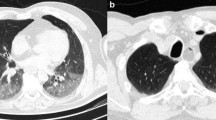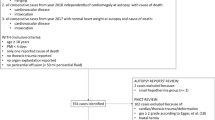Abstract
Purpose
We sought to compare postmortem chest computed tomography (CT) features of drowning cases with autopsy findings, and to classify these features.
Materials and method
We performed a retrospective analysis of high-resolution and multi-planar reconstruction chest CT images of drowning in 92 adults (54 men, 38 women; mean age 65.4 years) scanned before forensic autopsy. The average lung CT number was calculated from whole-lung images reconstructed on a 3D workstation. The statistically significant differences of CT numbers were assessed with an alpha level of 0.05.
Results
Postmortem chest CT image patterns were classified into six types: the two main types were ground-glass opacities with thickened pulmonary interstitium (n = 31), and a centrilobular distribution of ill-defined nodules along the airways (n = 38). Some cases were mixed type (n = 10). There were significant differences in CT numbers between each type. The remaining three types were consolidation (n = 5), emphysema and/or fibrosis (n = 4), and unclassifiable (n = 4).
Conclusion
Postmortem CT images of drowning cases can be classified into three major types with a few exceptions.








Similar content being viewed by others
References
World Health Organization Fact sheet N347. Drowning. Geneva, Switzerland: WHO; 2012.
Spitz DJ. Investigation of bodies in water. In: Spitz WU, editor. Medico-legal investigation of death: guidelines for the application of pathology to crime investigation. 4th ed. Spring-field: Charles C Thomas; 2006. p. 846–81.
Saukko P, Knight B. Immersion deaths. In: Saukko P, Knight B, editors. Knight’s forensic pathology. 3rd ed. London: Edward Arnold; 2004. p. 395–411.
Christe A, Aghayev E, Jackowski C, Thali MJ, Vock P. Drowning-post-mortem imaging findings by computed tomography. Eur Radiol. 2008;18:283–90.
Persson A, Lindblom M, Jackowski C. A state-of-the-art pipeline for postmortem CT and MRI visualization: from data acquisition to interactive image interpretation at autopsy. Acta Radiol. 2011;52:522–36.
O’Donnell C, Woodford N. Post-mortem radiology––a new sub-speciality? Clin Radiol. 2008;63:1189–94.
Kawasumi Y, Kawabata T, Sugai Y, Usui A, Hosokai Y, Sato M, et al. Assessment of the relationship between drowning and fluid accumulation in the paranasal sinuses on post-mortem computed tomography. Eur J Radiol. 2012;81:3953–5.
Verschakelen JA, De Wever W. Computed tomography of the lung. A pattern approach. Berlin: Springer; 2007.
Levy AD, Harcke HT, Getz JM, et al. Virtual autopsy: two- and three-dimensional multidetector CT findings in drowning with autopsy comparison. Radiology. 2007;243:862–8.
Kim KI, Lee KN, Tomiyama N, Johkoh T, Ichikado K, Kim CW, et al. Near drowning: thin-section CT findings in six patients. J Comput Assist Tomogr. 2000;24:562–6.
Hunter TB, Whitehouse WM. Fresh-water near-drowning: radiological aspects. Radiology. 1974;112:51–6.
Franquet T, Giménez A, Rosón N, Torrubia S, Sabaté JM, Pérez C. Aspiration diseases: findings, pitfalls, and differential diagnosis. Radiographics. 2000;20:673–85.
Shiotani S, Kohno M, Ohashi N, Yamazaki K, Nakayama H, Watanabe K, et al. Non-traumatic postmortem computed tomographic (PMCT) findings of the lung. Forensic Sci Int. 2004;139:39–48.
DiMaio VJ, DiMaio D. Forensic pathology. 2nd ed. Boca Raton: CRC Press; 2001.
Funayama M, Aoki Y, Sebetan IM, Sagisaka K. Detection of diatoms in blood by a combination of membrane filtering and chemical digestion. Forensic Sci Int. 1987;34:175–82.
Lunetta P, Modell JH. Macroscopical, microscopical, and laboratory findings in drowning victims: a comprehensive review. In: Tsokos M, editor. Forensic pathology reviews, vol. 3. Totowa: Humana Press; 2005. p. 3–77.
Germerott T, Preiss US, Ebert LC, Ruder TD, Ross S, Flach PM, et al. A new approach in virtopsy: postmortem ventilation in multislice computed tomography. Leg Med (Tokyo). 2010;12:276–9.
Germerott T, Flach PM, Preiss US, Ross SG, Thali MJ. Postmortem ventilation: a new method for improved detection of pulmonary pathologies in forensic imaging. Leg Med (Tokyo). 2012;14:223–8.
Storto ML, Kee ST, Golden JA, Webb WR. Hydrostatic pulmonary edema: high-resolution CT findings. Am J Roentgenol. 1995;165:817–20.
Gruden JF, Webb WR, Warnock M. Centrilobular opacities in the lung on high-resolution CT: diagnostic considerations and pathologic correlation. Am J Roentgenol. 1994;162:569–74.
Webb WR. Thin-section CT of the secondary pulmonary lobule: anatomy and the image––the 2004 Fleischner lecture. Radiology. 2006;239:322–38.
Conflict of interest
No potential conflicts of interest were disclosed.
Author information
Authors and Affiliations
Corresponding author
About this article
Cite this article
Usui, A., Kawasumi, Y., Funayama, M. et al. Postmortem lung features in drowning cases on computed tomography. Jpn J Radiol 32, 414–420 (2014). https://doi.org/10.1007/s11604-014-0326-9
Received:
Accepted:
Published:
Issue Date:
DOI: https://doi.org/10.1007/s11604-014-0326-9




